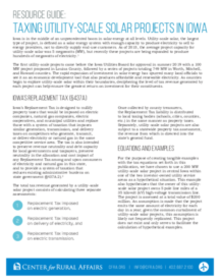Iowa is in the middle of an unprecedented boom in solar energy at all levels. Utility-scale solar, the largest type of project, is defined as a solar energy system with enough capacity to produce electricity to sell to energy providers, not to directly supply end-use customers. As of 2018, the average project capacity for utility-scale solar was 5 megawatts (MW), but recently these projects are being expanded to produce hundreds of megawatts of electricity.
The first utility-scale projects came before the Iowa Utilities Board for approval in summer 2019 with a 100 MW project proposed in Louisa County, followed by a series of projects totaling 749 MW in Worth, Mitchell, and Howard counties. The rapid expansion of investment in solar energy has spurred many local officials to see it as an economic development tool that also produces affordable and renewable electricity. As counties begin to explore utility-scale solar within their boundaries, deciphering the level of tax revenue generated by each project can help ensure the greatest return on investment for their constituents.


